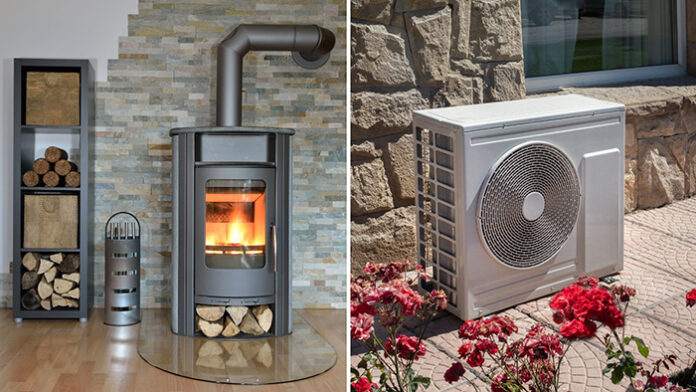So many of us rely on wood stoves for our home heating on Salt Spring and the Southern Gulf Islands, but have you considered the cost of burning wood on our community’s air quality?
“The fact is, wood stoves release a lot of pollutants that create health problems,” says Transition Salt Spring’s Morgan Fraser.
Fraser leads the Climate Action Coach program at Transition Salt Spring, which offers free advice and local rebates for making your home more climate-resilient.
While wood is renewable, when burned in wood stoves and fireplaces, it releases significant amounts of harmful substances, especially PM 2.5, which studies show negatively affects respiratory illness and increases the risk of heart attack or stroke. Vulnerable folks like the elderly, children, and people with heart and lung conditions are most likely to be affected. Removing one old, dirty, inefficient wood stove is equivalent to the PM2.5 pollution reduction of taking five old diesel buses off the road, according to the EPA.
“At Transition Salt Spring, we recommend anyone with an old wood stove to upgrade to a Heat Pump as their primary heating source and use their existing wood stove during power outages and in extreme cold as supplementary heat. If a heat pump isn’t accessible to you, we also offer a rebate to upgrade to an EPA-2020 Certified wood stove,” says Fraser.
Transition Salt Spring is offering rebates to Salt Spring and Southern Gulf Island residents of $500 to $1,000 to upgrade your uncertified wood stove to a heat pump or EPA-2020 certified wood stove. There is also the option to remove your uncertified wood stove and receive a $300 bounty with no heat upgrade. Funded by the BC Lung Foundation and BC Ministry of Environment and Climate Change Strategy, this is stackable with other provincial and federal rebates available for heat pumps.
If you burn wood in the colder months, what matters is how you burn the wood. If you burn wet wood or let it smoulder, the resulting fire adds significant particulate matter into the atmosphere. The smoke is the problem. Burning wood inefficiently can also release excess methane, a gas with a greenhouse impact 20 times greater than CO2. Burning wood in an open fireplace releases large amounts of ash in the smoke. Wood smoke becomes air pollution once it leaves the chimney.
5 Tips for Burning Wisely
1. Season wood outdoors for at least seven months before burning it. Properly seasoned wood is darker in colour, lighter in weight, has cracks in the end grain, and sounds hollow when smacked against another piece of wood.
2. Store wood outdoors, stacked neatly off the ground, with adequate airflow, and protected from the elements — stack wood with the bark-side facing down for quicker drying.
3. If you have yet to build a woodshed, build it south facing to allow the sun to aid in drying. Cool, damp north-facing firewood sheds retain moisture and can get mouldy.
4. If you’re buying wood, aim to buy waste wood from a sustainable source on the island in the springtime: stack it, store it, protect it from the elements, and you will have dry wood by fall. Firewood also usually costs less in spring than during the fall’s “we’re out of firewood!” buying frenzy.
5. When maintaining a fire, burn small, hot fires as they produce far less smoke than ones left to smoulder. It bears repeating – when one burns wood inefficiently, the resulting smoke contains a number of chemicals, such as carbon monoxide (CO), VOCs, Nitrogen Dioxide, and PM2.5.
“Transition Salt Spring has worked with Salt Spring Fire Rescue to provide education on the best practices for using a wood stove. Take an hour to watch our All About Wood Stoves video on YouTube. Even seasoned wood stove users can learn new tips to improve their wood stove usage,” says Fraser. “Also consider the improvements to your household when upgrading — oftentimes, you will save money monthly by using less wood and greater energy efficiency. If you are able to upgrade your old uncertified wood stove to a heat pump or EPA-2020 wood stove, our Community Wood Smoke Reduction Program rebate helps empower you to save money while improving both your home and our community.”
People can join the interest list for this rebate at TransitionSaltSpring.com/Coach.
For more information about other Transition Salt Spring programs, see transitionsaltspring.com.

